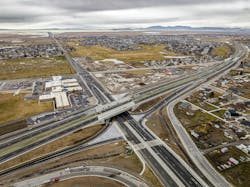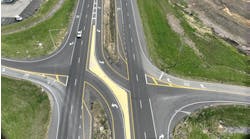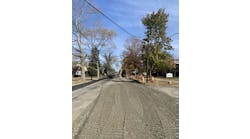By Bryan Adams and Bethany Shingleton, Contributing Authors
When ground was broken for the West Davis Highway in May 2021, Carlos Braceras, executive director of the Utah Department of Transportation (UDOT), noted how the project had been a goal of state transportation officials for more than 60 years.
“Thousands of people have worked to get us to the point where we're at right now, and it's probably thousands and thousands of people,” Braceras told the gathered officials and project leaders.
The $800 million project opened to traffic in January 2024, on budget and months ahead of schedule. It did so thanks to a team that prioritized effective coordination, made proactive decisions, and was involved in the project from the early environmental stages to the construction and opening.
They created the best road possible for the communities it serves — a rapidly growing region north of Salt Lake City, where congestion is a concern.
The four-lane West Davis Highway stretches 16 miles through six cities in western Davis County, north of Salt Lake City.
From Centerville in the south, it travels across the western edges of Farmington, Kaysville, Layton, Syracuse and ends in West Point.
Along the way, the highway includes five new local grade-separated interchanges, a major system interchange with Interstate-15/Legacy Parkway and more than 10 miles of new trail and trail connections.
The new highway is expected to reduce congestion in the fast-growing region and accommodate the future needs of ongoing growth.
The region’s cities have grown from 10%-30% in the past 10 years and predictions indicate that pace will continue.
The West Davis Highway will help manage the traffic generated by that growth and position the region well for the coming decades.
Partnerships
HDR worked with UDOT for nearly 15 years to see the West Davis Corridor through to completion, starting with work on the Environmental Impact Statement (EIS) and concept designs.
The environmental phase began in 2010, when the team evaluated 51 alternatives for their potential impact and worked with communities and UDOT to determine the best option. What followed was a seven-year journey to a record of decision.
The community had a stake in this project, and along with the consistency that came with retaining HDR as project manager, listening to the feedback from residents was a key to success.
Community interest was high, and engagement was a constant theme as the project unfolded.
After proposed route alternatives were released during the environmental process, more than 2,000 residents attended open houses explaining the alternatives, and more than 3,000 comments were received. That’s about one comment for every 40 adults in the six cities the highway touches.
Listening to the community’s opinions and comments, the team refined the alignments to reduce impacts to residents and the natural environment. The design incorporated noise-reducing pavement, significant trail connections, mostly ground-level construction, and lighting only at interchanges, specially designed to preserve dark skies and not interfere with nocturnal wildlife.
These features were in addition to a 1,100-acre wetland mitigation area that was also developed.
To ensure the West Davis project was understood and accepted, the team developed 30 technical memorandums throughout the seven-year environmental phase to explain UDOT’s methodologies and decision process.
Charettes were also held with neighborhoods and communities to get their input on how the roadway should look and what aesthetic treatments to pursue.
During construction, a community group with representatives from each city met each month to discuss issues and concerns, such as perceived unsafe conditions, problems with traffic, etc.
The feedback from this group was relayed to the contractor, who responded as necessary. Importantly, the group had more than just an advisory role. The contractor received an incentive for meeting community expectations, and this group had the responsibility of determining how much of that incentive to award. These meetings were held with the contractor, so they had first-hand knowledge of the challenges and could implement changes such as sweeping the roadways more, watering the grade to reduce dust, or modifying detour routes to accommodate community events.
Ultimately, the contractor received most of the incentive, showing their responsiveness to the community and the value of this group in providing a venue for raising concerns.
Planning Ahead
On such a large project, it was important to carefully consider upcoming risks and challenges so they could be addressed before becoming a problem.
Multiple workshops took place during the early design phase to identify the top risks and opportunities for mitigation strategies.
These were incorporated into a comprehensive risk matrix that was then used to develop the requirements in the request for proposal (RFP), as well as to highlight potential areas for innovation from design-builders.
For example, the nearby Layton Canal, used to deliver irrigation water to local farmers, was identified as a top risk, so the team developed plans for an early relocation package and hired a contractor to relocate the canal ahead of selecting a design-builder.
The team also conducted early informational meetings with each of the interested design-build teams.
These meetings provided feedback and led to early information packages that were created prior to releasing the draft RFP.
The procurement schedule was also specifically organized to allow enough time for design-builders to prepare alternative technical concepts and suggest innovations.
As a result, UDOT received more than 140 alternative technical concepts (ATCs), ultimately resulting in the winning bid being $60 million less than the engineer’s estimate.
Construction Schedule
Construction began in January 2021, during a global pandemic. Like many projects, the West Davis team faced material price escalations and shortages of materials.
Staying on track required a proactive approach to ensure the project continued to hit milestones. Looking ahead to upcoming needs, the team was able to identify looming challenges and brainstorm ways to address them.
For example, some of the concrete pipe called for in original plans was unavailable and substitutions were required.
In another instance, multiple local suppliers had been retained to cast catch basins for the road. But because of supply and labor shortages, it became clear that they would not be able to keep up with the pace of construction. As a result, the design-builder became certified to cast boxes on site. This solution allowed the project to keep moving and avoid delays.
The dashboard used on the project was also a key part of maintaining schedule, budget and tracking submittals. The comprehensive and collaborative dashboard tracked design, construction, and administrative submittals with clear, concise data.
It also provided value to the contractor by keeping them up to date on all relevant information. Graphics, charts, and metrics reported schedule progress and changes to the design-builder’s schedule, allowing the team to focus on what was most important and create efficiencies during schedule and change order reviews.
During contract administration, the data was used for change order evaluation, resulting in the project coming in within budget.
Community Embrace
Construction was substantially completed in December 2023, and the new highway opened to traffic on Jan. 6, 2024. It was clear that the community was excited about the new road. About 2,500 people showed up for grand opening, and when barricades were lifted, lines of traffic were already waiting to use it.
In the weeks and months since, the enthusiasm hasn’t dimmed. Some residents have said the new road reduces their commute times by 20-30 minutes.
“Time is the one thing we can’t make more of, and we expect this highway to reduce delays by more than 30 percent on local roads,” Braceras said when the West Davis Highway opened. “It also includes trails for people who want to walk, bike, or even ride a pony.
“Utah continues to be the fastest growing state in the country, so it’s crucial for us to provide a holistic transportation system that offers people choices to get where they want, when they want, in the way they want – safely. As the West Davis Highway opens its lanes, it's not just about roads; it's about connecting communities and the countless journeys it will enhance.” RB
Bryan Adams is a senior project manager and led HDR’s program management work on the West Davis Corridor.
Bethany Shingleton is a project manager and office principal for HDR in Salt Lake City. She has worked on the West Davis Corridor since 2010.








